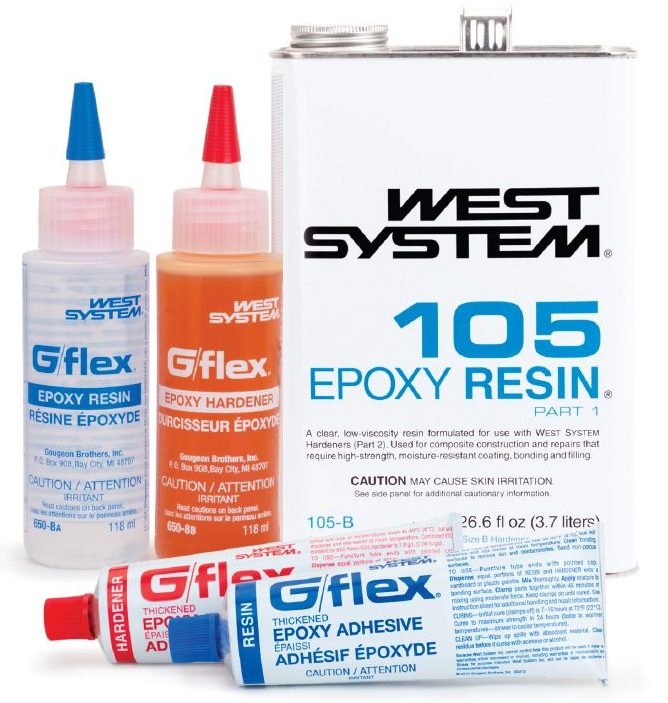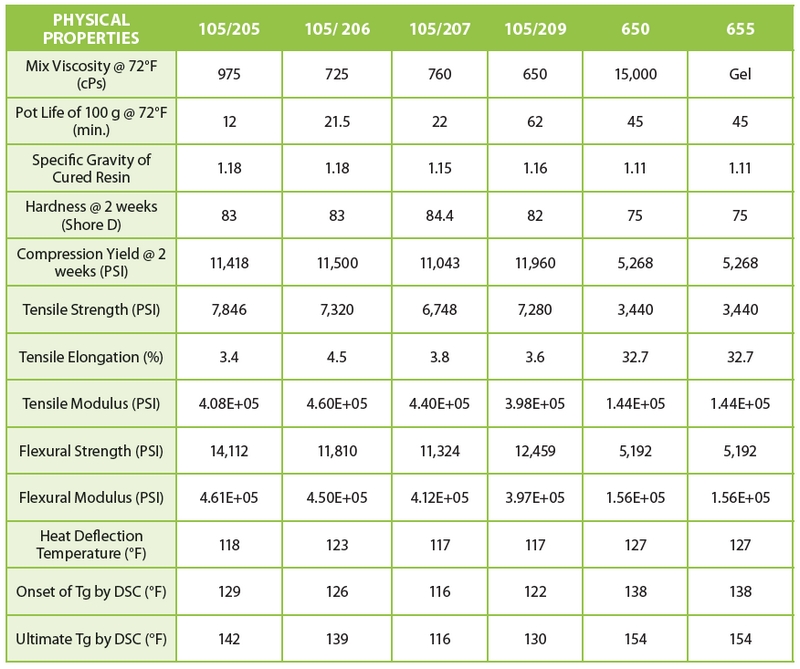
Take the quiz
By Don Gutzmer – GBI Technical Advisor
“Should I use the 105 System or G/flex® Epoxy for my project?” This is a great question. Here’s what a Technical Advisor thinks about when recommending one type of WEST SYSTEM® Epoxy over another. Let’s start by comparing the handling characteristics and mechanical properties of both the 105 System and G/flex. This will show you the advantages of each and when one system is better suited over another for your project.
105 System
WEST SYSTEM 105 Resin mixed with any 200 Series Hardener has a viscosity similar to 50-weight motor oil or warm corn syrup. It is pourable and great for coating or bonding applications. The 105 System is versatile because you can select one of four hardeners for the working time you need. If clear coating, choose 105 Resin and 207 Special Clear Hardener. The epoxy can be modified with any of the six WEST SYSTEM Fillers to create a thickened adhesive or fairing compound. For information on fillers, see my article “The Basics of WEST SYSTEM Epoxy” in Epoxyworks 49.
Additives can also be used to modify the mixed epoxy, such as 420 Aluminum Powder, 422 Barrier Coat Additive and 423 Graphite Powder. You can tint epoxy with a variety of pigments or dyes up to 2% by weight while still maintaining similar structural properties.
The low-viscosity of the 105 System is advantageous for easily wetting out fiber reinforcements such as fiberglass and carbon fiber. Because of the lower viscosity, it releases air more effectively to ease self-leveling.
Consider what mechanical properties you need from an epoxy system when deciding on which formulation is best. On the next page is a comparison chart of the physical properties of various WEST SYSTEM Epoxy formulations.
You will notice that when cured at 72°F (22°C) for two weeks, the 105 Resin System has a compression strength of around 11,000 pounds per square inch, or psi, and tensile strength around 7,000 psi. The ultimate tensile elongation averages 4% for 105 Resin and 200 Series Hardeners.
Using the epoxy for fastener bonding takes full advantage of its mechanical properties. Hardware on the deck of a boat can be under high load. The high tensile strength the 105 System provides is needed to prevent failure of the fasteners. For most general applications, the epoxy is stronger than what is ultimately needed for bonding and coating.
Another thing to consider when determining if the 105 System or G/flex is a better option is the substrate you’ll use. The 105 System will bond well to most substrates like wood, fiberglass, concrete, and ceramic. G/flex bonds better to certain high-density woods, plastics or metals.
Now let’s talk about what G/flex Epoxy has to offer.
G/flex Epoxy
There are two versions of G/flex: 650 and 655. The liquid version, G/flex 650, has a viscosity similar to honey and the thickened version, G/flex 655, is similar to gelled toothpaste. Both versions of G/flex can also be modified with any of the six WEST SYSTEM Fillers and any 400-series additives mentioned earlier. Using a high-viscosity system for bonding offers the advantage of bridging gaps. The base resin of G/flex is much higher in viscosity than the 105 System.
We prefer G/flex for bonding together dissimilar substrates such as metals and exotic woods.
G/flex epoxy’s advantage is that it can bond to many substrates, even those that are considered difficult: white oak, Ipe, damp woods, aluminum, copper, stainless steel, PVC, high-density polyethylene, polycarbonate, and many others.
The toughness of an epoxy formulation is measured by tensile elongation and strength.
G/flex was formulated to have a high ultimate tensile elongation of around 30%. If you are bonding to stainless steel that has been sanded with 80-grit, the average tensile adhesion for the 105 System is 1,000 psi and for G/flex it is 2,400 psi. G/flex has a tensile strength averaging 3,400 psi and a compression strength of around 5,200 psi.
Do you think like a Technical Advisor?
Put your knowledge of the 105 System and G/flex to the test. Select between 105 System or G/flex epoxy for the most suitable epoxy for these real customer applications.
- I need to bond an aluminum jib car track onto my fiberglass sailboat. Which epoxy is recommended?
- I have a small damaged area on my carbon fiber mast that I’m going to repair with carbon fiber cloth. Which epoxy is recommended?
- Which epoxy is recommended for applying fiberglass cloth to a cedar strip canoe?
- My high-density polyethylene canoe has a crack on the hull side. Which epoxy do you recommend to repair it?
- I need to fill a river table with epoxy. Which epoxy is best?
- I want to coat the edge of a wooden paddle to minimize impact damage. Which epoxy should be used?
- What epoxy formulation is best for embedding boat cleat fasteners into my deck?
- I need to repair the crack on my sailboat’s keel-to-hull joint. Which epoxy is recommended?
- I need to bond the plywood transom onto my Hypalon dingy. Which epoxy is best?
- What epoxy is recommended to coat a fiberglass boat, creating a barrier coat?
Did you answer them all? No peeking!
Answers
- I need to bond an aluminum jib car track onto my fiberglass sailboat. Which epoxy is recommended?
G/flex is recommended for bonding dissimilar materials like aluminum and fiberglass because it is a toughened system. The 30% elongation allows the flexibility needed for bonding materials that may move at different expansion rates.
- I have a small damaged area on my carbon fiber mast that I’m going to repair with carbon fiber cloth. Which epoxy is recommended?
The 105 System is a better option for repairing carbon fiber because it provides higher mechanical properties. The carbon spreader can be subject to high loads, and the 105 System’s average tensile strength of 7,300 PSI and average compression strength of 11,500 PSI provide the mechanical properties needed for a lasting repair. It will also easily wet out and saturate the carbon fiber cloth.
- Which epoxy is recommended for applying fiberglass cloth to a cedar strip canoe?
The best option for fiberglassing a cedar strip canoe is 105 Resin and 207 Special Clear Hardener. The 105/207 will easily wet out lightweight fiberglass and provide a clear epoxy coating. G/flex will give the canoe a cloudy, caramel hue and its high viscosity makes it difficult to quickly wet out fiberglass without entrapped air bubbles.
- My high-density polyethylene canoe has a crack on the hull side. Which epoxy do you recommend to repair it?
For repairing a cracked HDPE canoe, G/flex is the best option. Proper surface preparation is crucial to ensuring a successful HDPE plastic repair. For bonding to high-density polyethylene, we recommend an alcohol wipe and then flame treatment with a propane torch. Move the flame at a rate of 12 to 16 inches-per-second over the repair area, similar to the speed you would use for spray painting. Flame-treating oxidizes the surface, improving the epoxy’s adhesion. A heat gun will not improve adhesion to HDPE; a propane torch is needed.
- I need to fill a river table with epoxy. Which epoxy is best?
A low-viscosity, clear epoxy is needed for castings in river tables. 105 Resin/207 Special Clear Hardener is the best WEST SYSTEM option. The epoxy can be tinted to the desired color, and its low viscosity makes air bubbles easier to remove. For most casting applications we recommend ¼” maximum thickness per pour.
- I want to coat the edge of a wooden paddle to minimize impact damage. Which epoxy should be used?
For the end of a wooden paddle, G/flex 650 should be used to take advantage of its toughness for greater impact resistance. It quickly builds up to a thick coating that helps absorb shock from impacts during use. As a thin coating, the epoxy deflects without cracking, maintaining adhesion to the wood beneath, when the wood gets dented.
- What epoxy formulation is best for embedding boat cleat fasteners into my deck?
The 105 System will provide better holding capacities for fastener bonding and can be thickened with a high-density filler for bridging gaps. G/flex can also be used in hardware bonding but the 105 System is stronger.
- I need to repair the crack on my sailboat’s keel-to-hull joint. Which epoxy is recommended?
G/flex 655 is recommended for repairing a cracked keel-to-hull joint. To prevent G/flex from running or sagging on a vertical surface, add 406 Colloidal Silica filler to achieve the desired consistency. G/flex’s high tensile elongation, allows it to endure more movement or flexing before failure offering better adhesion to dissimilar substrates.
- I need to bond the plywood transom onto my Hypalon dingy. Which epoxy is best?
G/flex bonds well to Hypalon that has been sanded with 80-grit. Any time you need to bond dissimilar materials, consider G/flex as an option.
- What epoxy is recommended to coat a fiberglass boat, creating a barrier coat?
The 105 Resin is an excellent barrier coat for fiberglass hulls. You can add the 422 Barrier Coat Additive to create an even more effective moisture barrier. This system’s low viscosity also makes it easier to roll onto large surfaces.
Now, a long answer to the short question, “Should I use the 105 System or G/flex?” The answer depends on multiple factors. What are you bonding to? Do you need a low-viscosity epoxy? Should the epoxy have high mechanical properties like tensile strength and compression strength? Does the epoxy need to be able to move or flex? Does the color of the epoxy matter? What will the cure temperature be? As a Technical Advisor, I quickly think through all these things when helping our customers make decisions on which epoxy formulation to select for their project.
For some applications, either epoxy system will work. However, if you get into a project and are not sure which WEST SYSTEM Epoxy product is your best choice, call our toll-free Technical Service line: 866-937-8797. Our goal is for every customer to have successful experiences using WEST SYSTEM products.
How did you do?
10 Correct – You’re well on your way to being a superb WEST SYSTEM Technical Advisor.
6-9 Correct – You’ve definitely been around the block a time or two, but practice makes perfect.
0-5 Correct – You’re a novice to WEST SYSTEM, but don’t worry, the pros are only a phone call away at 866-937-8797.






